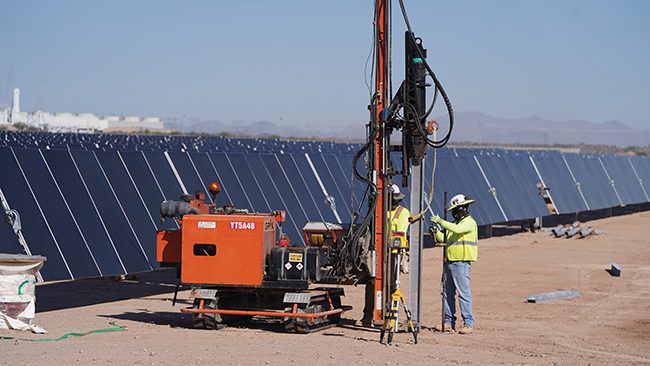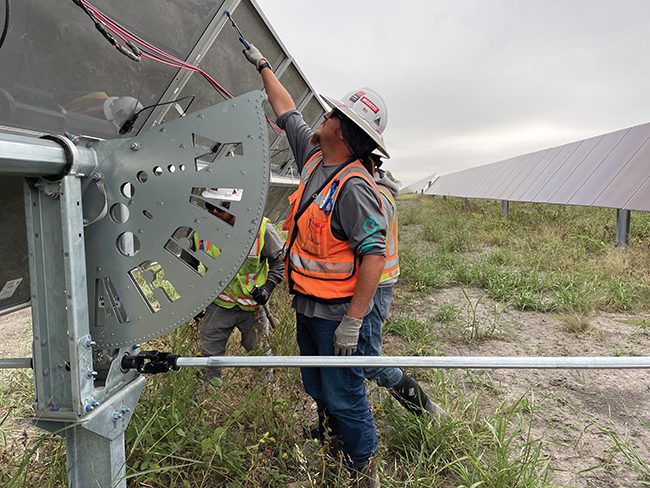Working with EPC Contractors: Guidance for Utilities Embarking on Solar Development
Engineering, procurement, and construction (EPC) contractors deliver many benefits to power projects. Besides the experience they bring that can help keep schedules on track, they often have longstanding relationships with suppliers that allow volume-based pricing discounts and priority sourcing of materials, among other things.
The U.S. Energy Information Administration (EIA) says the U.S. is set to add 63 GW of photovoltaic (PV) power by the end of 2024. This is a huge stride forward for renewable energy, as solar and wind generation is expected to reach 16% of the U.S. grid’s supply this year. That’s an increase of 84% in just two years for solar production alone. With the Inflation Reduction Act (IRA) in place, the trajectory for solar will most likely continue to soar and the utilities that opt to build and own solar plants will reap the rewards.
How to Take Advantage of the Inflation Reduction Act
With President Biden’s signature on the IRA, the new legislation that dedicates $369 billion to combating climate change through investments in renewable energy, building and owning utility-scale solar projects just got more attractive to utilities across the U.S.
 |
|
1. McCarthy Building Companies mobilized its workforce in September 2022 to construct the Agave Solar Plant, a 150-MWac facility located in Arlington, Arizona. The plant is expected to be in service providing power to Arizona Public Service Co. (APS) customers in time for summer 2023. Courtesy: McCarthy Building Companies |
While there will continue to be a need for utilities to contract with solar developers under power purchase agreements (PPAs), the IRA incentivizes utilities to explore the option of owning PV plants themselves. That means working directly with engineering, procurement, and construction (EPC) contractors to design and build solar projects that make the most sense for their region, load profiles, and regulatory environment (Figure 1).
One of the first choices utilities will need to make for their solar projects is whether the investment tax credit (ITC) or the production tax credit (PTC) makes more sense. Previously, owners of solar assets were eligible only for the ITC, which was calculated based on total project cost. With passage of the IRA, owners of solar projects now have the option of choosing either the ITC or the PTC, which is a 10-year stream of tax credits calculated based on actual plant production. Publicly owned, not-for-profit entities such as municipal utilities and cooperatives have the additional option of receiving an amount equal to the ITC or PTC as a direct payment from the U.S. Treasury, rather than a tax credit.
Under the framework of the IRA, the ITC is equal to 30% of total qualifying costs for projects that meet certain requirements with respect to prevailing wages and apprenticeship ratios, with adders of 10% each for domestic content and for siting the project in an “energy community.” Alternatively, a utility could opt to pursue the PTC at a rate of 2.7 cents/kWh (provided the project complies with certain prevailing wage and apprenticeship requirements) with adders of 0.3 cent/kWh for domestic content minimums and another 0.3 cent/kWh for siting in an “energy community.” Additionally, the PTC is adjusted annually for inflation and is not subject to the accounting rules related to “normalization,” which have historically prevented utilities from efficiently utilizing the ITC.
“EPCs aren’t able to prescribe what makes the most financial sense for the utility with respect to the election of ITC or PTC, but they are able to help model the inputs that utilities need to weigh these two options. Additionally, EPCs can develop labor, procurement, and scheduling strategies that help utilities take maximum advantage of available incentives. And they can take the headaches away from some of the complicated reporting requirements,” said Chester Klotz, vice president of renewable energy for McCarthy Building Companies. “In the past, developers have been able to more effectively use the benefits of the ITC, but the IRA has essentially changed the solar facility landscape, putting utilities on a more level playing field financially.”
Understanding all the options available under the IRA—and the necessary reporting and compliance—requires expertise that experienced and sophisticated utility-scale EPCs are able to provide. These EPCs will be able to optimize a particular project’s tax credits by ensuring that Davis-Bacon Act prevailing wages are paid to workers and that a sufficient number of registered apprentices are utilized.
 |
|
2. McCarthy was selected by Lightsource bp as the engineering, procurement, and construction (EPC) contractor for its Elm Branch and Briar Creek solar farms, both located south of Dallas, Texas. McCarthy trained many area residents and military veterans to work on these projects. Courtesy: McCarthy Building Companies |
At the Elm Branch and Briar Creek solar projects outside Dallas, Texas, McCarthy Building Companies’ Renewable Energy and Storage team worked with Adaptive Construction Services (ACS) to develop a U.S. Department of Labor–approved apprenticeship program that employed approximately 50 U.S. military veterans (Figure 2), who built the combined 316-MW solar farms or completed on-site training. The apprenticeship program is now implemented on projects that the firm builds around the country.
“With utility-scale solar construction jobs on the rise around the nation, we are continually working to help local skilled craft workers, veterans, and those displaced from jobs in other sectors to join our solar project teams and receive the training needed to develop rewarding careers in the growing renewable energy sector,” said Matt McMullan, senior vice president of renewable energy for McCarthy Building Companies. “Now, with the IRA, utilities can be rewarded with federal incentives for implementing programs that create good-paying jobs and expand workforce training pathways into these jobs.”
Building to Solar Industry Standards
As more utilities navigate the engineering and construction of solar projects they will own and operate, it’s important that utilities keep an open mind and are flexible when new ideas or solutions are presented by their EPC partner. They are able to pass along lessons learned from a broad spectrum of project sites they’ve built.
“Utilities have a playbook on how to design and build combined cycle generating plants and many try to apply that playbook to solar plants,” said Mark Skidmore, PE, director of engineering and R&D (research and development) for McCarthy Building Companies. “While that’s understandable, it doesn’t always make engineering or financial sense.”
EPCs help evaluate design decisions to achieve the goals of the solar plant and bring innovations to utilities that may be new to the area of development. Collaboration is key to success. For example, if a utility’s goal is to generate 500 GWh for the life of a project with a specific production profile, an EPC would come to the table with design and equipment recommendations needed to reach that end goal based on modeling of data, experience, and reputable third-party research that back up those recommendations.
“As a utility owner, we’re most likely building to a bit of a different standard than the market because of the long-term view we take on assets,” said Jim Piotrowski, director of renewable generation with Arizona Public Service (APS). “For our 150-MWac Agave solar project in Arlington, Arizona, it was helpful to collaborate with the EPC to come up with solutions that, based on their experience, provided the redundancy and reliability we need, and determine how we can achieve what we need to for the project’s lifecycle in the most cost-effective way.”
Collaborative design and value engineering are key benefits that an experienced EPC can bring to the table, and their importance should not be understated. Those types of conversations between the utility and the EPC should be taking place early and often.
Managing Sequencing, Scheduling, and Supply Chain Issues
Once a utility has a site selected and plans engineered for a solar farm, an EPC can help ensure timely project delivery and navigate potential challenges with equipment orders.
Today, solar modules are considerably cheaper, with the Solar Energy Industries Association (SEIA) reporting that prices have fallen 52% over the last 10 years. This, combined with the tax credits available in the IRA, have made the development of utility-scale solar projects more economically feasible for utilities.
Of critical importance is selecting an EPC that keeps up to date with current solar technology. Performance and pricing for modules, inverters, and trackers are constantly changing with improvements in technology being released all the time. Now that the IRA established two credits for manufacturing, there will likely be an uptick in solar products that can make a difference in cost or performance of the PV plant.
EPCs should have established relationships with reputable vendors and master purchase agreements that result in the best pricing, lead times, and the ability to execute contracts quickly. Some utilities try to save money by ordering parts directly, only to find it ends up costing more in the long run because they hit snags with delivery that, in some cases, result in delayed projects. Doing this can take away leverage that the EPC has with product suppliers and transfers the risk of supply chain issues from the EPC to the utility. While it can make sense for a utility to purchase modules or other elements of their solar project in some cases, EPCs are equipped to help in this process and even manage it for utilities that are new to the process of constructing and owning solar plants. Understanding what makes sense for each project involves transparent communication between the utility and EPC.
“At APS, we take a long-view approach to renewable energy project planning and development, partly because of our experience as solar facility owners, but also due to current market conditions related to solar module availability,” stated Piotrowski. “We’re managing lead times for procurement on long lead parts by ordering in advance of construction and while utilities newly entering this space may need to rely on the EPC for this, our EPC partners provide for procurement flexibility that allows us to plan ahead and they design the project based upon our equipment, site topography, and our clean energy generation needs.”
Additionally, an EPC is able to vet vendors to ensure they can deliver financially on a client’s significant product investment. COVID, wars in other parts of the globe, and shipping container issues have all presented challenges to solar project teams in recent years. Despite these unprecedented times, EPCs are set up to provide a turnkey, fixed-price, date-certain contract. The value-added solution reduces the complexity of building and owning a solar plant for the utility.
“Having developed numerous large-scale solar facilities over the years, APS appreciates working with experienced EPCs for the value they bring,” said Piotrowski. “We find that successful projects require early and frequent transparent communication that allows us to collaborate with our EPC partners by sharing our project and sustainability goals as well as what we’re bringing to the table. While collaboration continues throughout a project’s construction, we can rely on the EPC to efficiently manage the design and construction process, which allows us to focus on providing affordable, reliable energy to our customers.”
—Scott Canada is senior vice president of the Renewable Energy and Storage group at McCarthy Building Companies, which provides EPC services on utility-scale solar projects across the U.S. McCarthy has built or is currently constructing more than 80 utility-scale solar energy projects, delivering a combined capacity of more than 9 GW of clean energy production and over 775 MWh of energy storage since 2010.